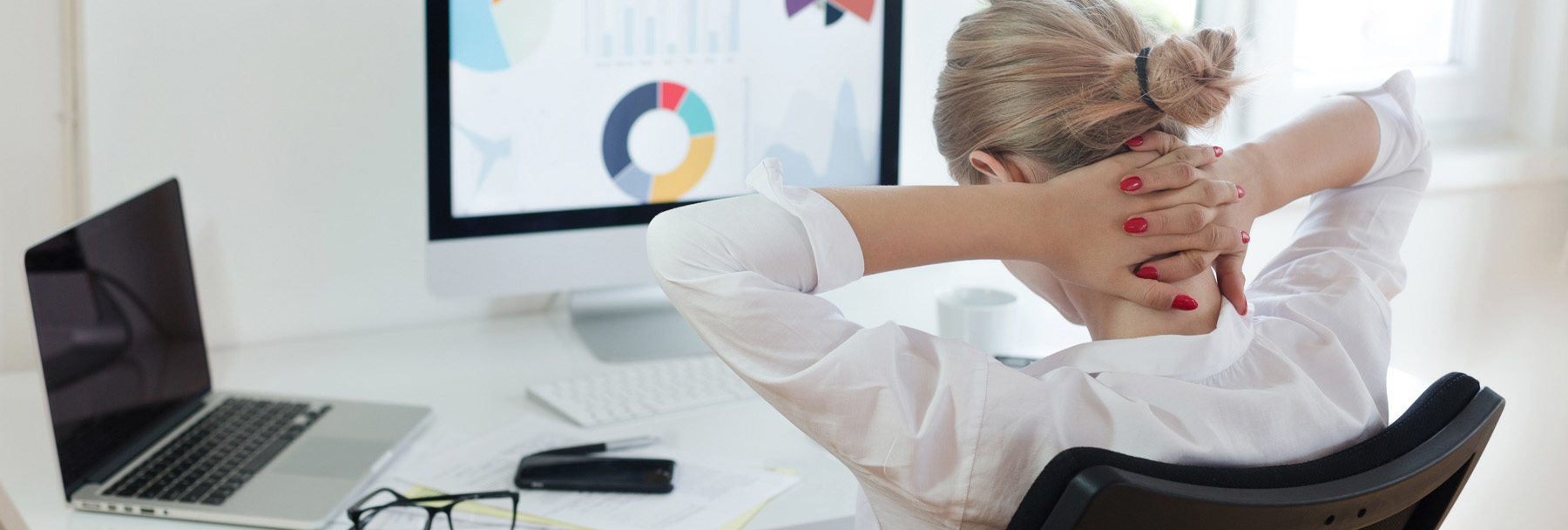Do You Suffer From Numb Thumb or Tech Neck?

Oh, how we love them, those devices that deliver the world to our fingertips and keep us connected to our friends and loved ones.
There’s a price to pay, however, for our devotion. Physicians are seeing more tech-related injuries and disorders as our dependence on gadgets — from smartphones to tablets — deepens.
“It’s great that it [technology] enables us to learn and process information so much more rapidly now,” says Patrick Owens, M.D., an orthopedic surgeon with the University of Miami Health System. “But we’re just beginning to learn about the potential downsides and the necessity of workplace ergonomics.”
In other words, the science of how our use of technology affects our health is in its infancy and good, consistent data is hard to find. “There isn’t as much as you would think for the amount of influence technology has on our lives at all levels,” he adds.
21st century digital world
Even simple statistics on technology use can be hard to come by, because what we use and how we use it can vary tremendously, especially among generations. We do know, from the Pew Research Center, that Americans increasingly connect to the internet, and that a growing number are doing it on mobile devices. A whopping 95 percent of Americans now own a cellphone. Seventy-seven percent haul around a smartphone, up from 35 percent in 2011. We own a range of other devices as well: three-quarters of adults own desktop or laptop computers, half of us tablet computers and about 20 percent e-reader devices.
We also spend a lot of time on these gadgets, especially our smartphones. Seventy-seven percent of us go online daily, including 26 percent who admit to being online almost constantly and 43 percent who do so several times a day, according to a Pew Research Center survey conducted in January 2018. Another survey, from pharmaceutical company, Shire, and media and technology company, Thrive Global, reported that about one in three U.S. adults use screens more than 10 hours each day. And when we’re not online checking Facebook or posting on Instagram or getting turn-by-turn driving directions, we’re busy texting — hopefully while not driving.
But here’s the catch: All this typing and reading and squinting affects us physically and mentally, though we still don’t know exactly how. There are many reasons for this lack of solid information. When our phone thumb grows numb, many of us simply rest the aching digit. Only the most severe cases make it to a doctor’s office. What’s more, troublesome injuries may be pooh-poohed by one person but treated enthusiastically by another.
“Every person has their own level [of discomfort and pain],” Owens says. “What might affect one person might not affect someone else. It depends on many factors.”
Numb thumb
The most common tech-related ailments Owens sees are carpal tunnel syndrome and tendonitis. Carpal tunnel, caused by a compressed nerve in the passageway along the palm side of your wrist, causes tingling and numbness in the hand and arm. Some people also experience weakness, with a tendency to drop objects.
While repetitive motions can contribute to the problem, Owens, a hand specialist, says the anatomy of your wrist and hands — even the size of the phone you use — may bear more of the blame. “It depends on the size of the phone, the size of the hand, even the age of the person,” he explains. “Small hands using large phones may have more pain at the base of the thumb.”
Numb thumb, or texting thumb, is caused by inflammation of the tendons around the thumb, usually from overuse. If you’re a speed texter sending hundreds of missives “you’re most likely to develop” the condition. Quite simply Owens adds, our thumbs were not designed to repeat the same movement on a small flat surface.
Tech neck
In addition, physicians are seeing more cases of tech neck or “text neck,” when the muscles around our neck grow sore and inflamed from reading on our devices for long hours with what health experts call “forward head posture.”
“We tend to look down on our devices, which puts a lot of strain on our neck,” Owens says. “It’s like putting a bowling ball on a string.”
While the potential to develop these conditions can be frightening, the orthopedist does offer some consolation: most respond very well to rest and icing.
“Most conditions associated with overuse don’t seem to carry long term issues or become incurable problems,” he says.
eTips
In the meantime, there’s plenty we can do to ease our muscular and joint aches as well as soothe our tired eyes:
- Take a break. You don’t have to sit in front of your computer or play with your phone constantly. At work move around, stretch, touch your toes — anything to help your relax and give your digits, your spine and your neck a rest.
- Support your forearms with a wedge when keyboarding or using a mouse.
- Use both thumbs. One shouldn’t get all the action.
- Sit up straight, like your mother told you. Your back should be pressed against your seat — no slouching and no moving your head forward. Good posture eases the pressure on your spine.
- Consider a standing desk. Ergonomic experts like them because it forces users to stare straight at the computer screen and it short-circuits the health dangers of too-much sitting.
- Hold your phone (or tablet) out instead of in your lap. It should be positioned in such a way that you can read while your head sits squarely on your shoulders.
- Try using the 20-20-20 rule recommended by eye specialists to reduce dry eye, headaches and eyestrain. This means looking at something that’s 20 feet away for at least 20 seconds every 20 minutes.
- Blink. Seriously. When we’re on our devices our blink rate is reduced by up to 50 percent, which can make our eyes itchy and our vision blurry.

Ana Veciana-Suarez, Guest Contributor
Ana is a regular contributor to the University of Miami Health System. She is a renowned journalist and author, who has worked at The Miami Herald, The Miami News and The Palm Beach Post. Visit her website at anavecianasuarez.com or follow @AnaVeciana on Twitter.
Last reviewed on September 18, 2023, by Dr. Patrick Owens, an orthopedic surgeon with the University of Miami Health System.

Originally published on: July 06, 2018
Tags: carpal tunnel syndrome, Dr. Patrick Owens, ergonomics, tech neck, tech-related injuries
